Seaman-Drake Arch
Introduction
Text-to-speech Audio
This marble arch behind an auto repair shop on Bradway is all that remains of the Seaman-Drake property, a grand mansion that stood from the mid 19th century until the late 1930s. The former mansion dated to 1855 and was called "Mount Olympus" by its owners, John F. and Ann Seaman. The arch marks the entrance to the former estate and is the second-oldest remaining structure in Inwood after the Dyckman Farmhouse. The arch was reportedly modeled on the French Arc de Triomphe. The former mansion stood atop the hill behind the arch, where the Park Terrace Gardens co-op now stands. The Seaman-Drake Arch, sometimes called the Inwood Arch, was constructed of locally quarried white marble.
Images
Sseaman-Drake Arch in 1910 photo (photographer unknown)
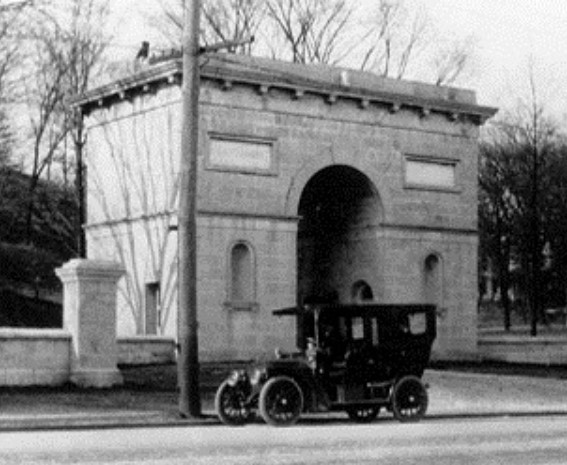
Seaman-Drake Mansion and Arch in 1903 photo (photographer unknown)
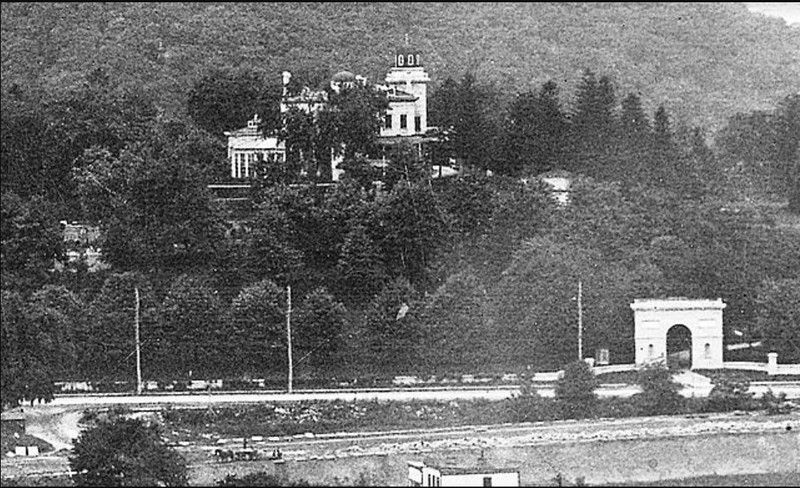
Top of Seaman-Drake Arch, behind auto repair building, in 2015 photo (Beyond My Ken)
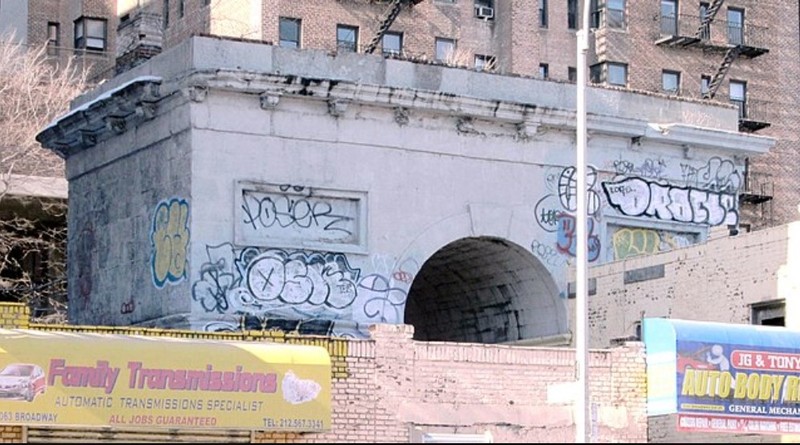
2015 view of Seaman-Drake Arch looking up (Beyond My Ken)
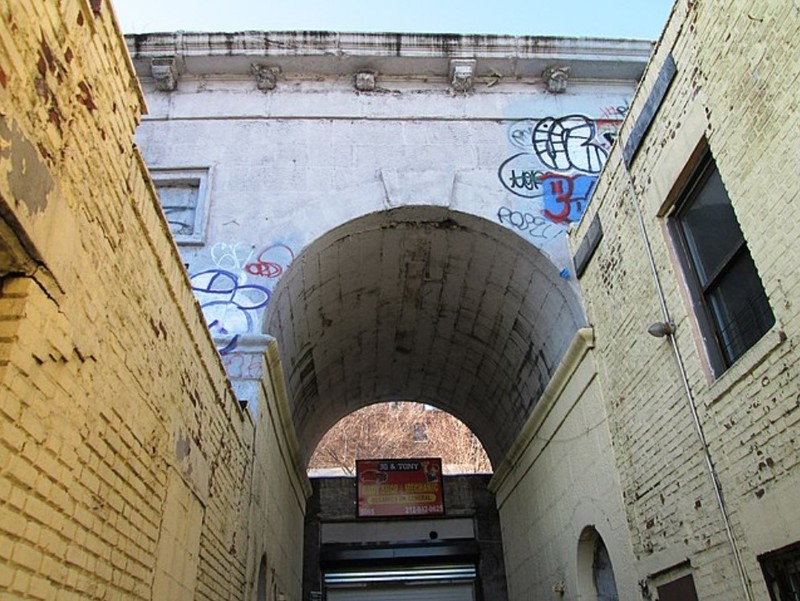
2010 view of Seaman-Drake Arch and neighboring buildings (NYS CRIS)
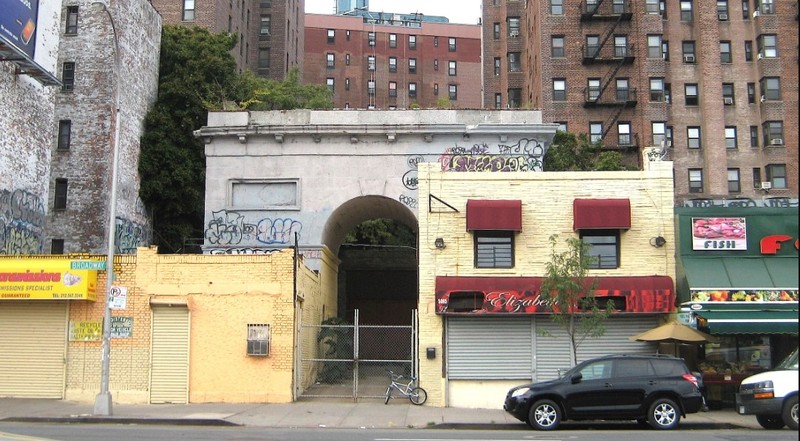
Seaman-Drake Arch (white x) on 1866 Valentine map; "Tubby Hook" was later renamed Inwood
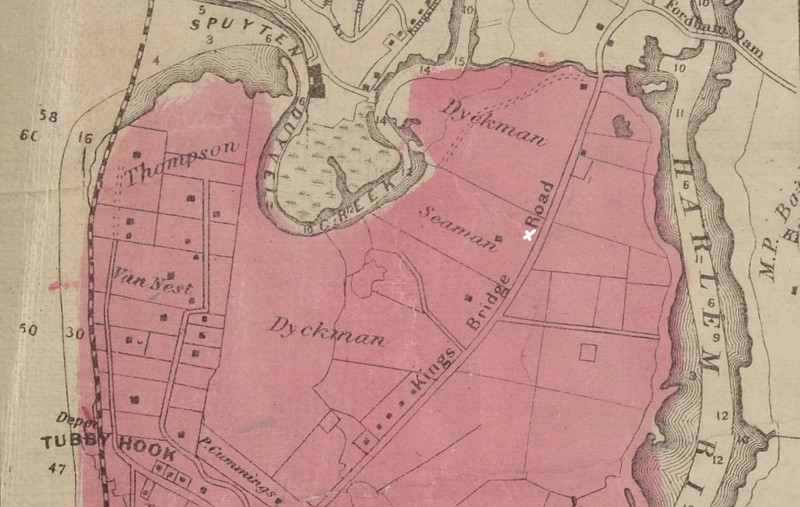
Backstory and Context
Text-to-speech Audio
John Ferris Seaman was a drug merchant and the son of Dr. Valentine Seaman, a physician who was instrumental in bringing a smallpox vaccine to the U.S. and who created the first school of nursing in the country. John married Ann Drake, the daughter of Susan Morgan, of the banking family. John bought 25 acres on a hilltop in Inwood in 1851 and had the mansion built by 1855. The over-the-top display of wealth in the marble mansion caused some to call the house "Seaman's Folly." The couple used the mansion as a country home; they had another house in Manhattan.
The white marble arch at the base of the hill was reportedly built to commemorate one of the childless couple's dogs and also functioned as a gatehouse to a winding drive that led up the hill to the mansion. The arch is 35 feet tall, 40 feet wide, and 20 feet deep. The front of the arch (facing Kingsbridge Road/ now Broadway) has 2 niches for statuary on either side of the barrel-vaulted archway and 2 plain panels above. The arch is topped by a projecting cornice and the interior of the arch had doorways and windows. The rear of the arch contained six windows on the upper level which probably lit the gatekeeper's quarters.
After John and then Ann died in the 1870s, the 25-room house was bequeathed to Ann's nephew, Lawrence Drake. The will was contested by relatives and was not settled until 1893. The Seaman-Drake mansion became the clubhouse of the Suburban Riding and Driving Club by the mid-1890s; Lawrence Drake was a member of the club.
Thomas Dwyer bought the mansion in 1905 and lived in the house and used the arch for his workshop and business, the Marble Arch Company. Dwyer was born in Ireland and is known for building the Soldier's and Sailor's Monument on Riverside Drive and part of the Metropolitan Museum of Art. The arch was the site of a woman's suffrage gathering on June 20, 1909. Known as the Votes for Women Outing, the demonstration in favor of women's right to vote was organized by the Equality League of Self-Supporting Women.
Dwyer listed the mansion for sale in 1913, calling it an "ideal place for a high-class boarding school" or a private sanitarium. The building featured an electric elevator, a swimming pool, and a solarium on the rooftop. Dwyer didn't sell the property until 25 years later, to developers in 1938. The new owners demolished the mansion and constructed the five-building, 400-unit Park Terrace Gardens on the site. The arch was not included in the sale. Dwyer moved into one of the new rental apartments at 10 Park Terrace East and lived to age 81, dying in 1943.
By the 1920s, low buildings had been built between the front of the arch and Broadway, containing a car dealership. The arch has been behind car repair shops since the 1960s. A fire in 1970 destroyed the roof of the arch and gutted the interior, hastening the structure's deterioration. The arch is covered in graffiti, ivy has grown up the interior walls, and acid rain has been eroding the marble surfaces. The building in front of the arch now holds Inwood Arch Automotive, Inc. Local efforts to designate the arch as historic have not been successful. The arch is considered not eligible for listing in the National Register of Historic Places.
Sources
Anonymous. "Thomas Dwyer, 81, A Retired Builder." New York Times (New York) March 5th 1943. Obituaries sec.
Marble Arch Co. "The Magnificent 'Marble Mansion'." New York Times (New York) February 2nd 1913. Advertisements sec.
Thompson, Cole. Seaman-Drake Arch, My Inwood. November 13th 2008. Accessed November 22nd 2021. http://myinwood.net/the-old-seaman-mansion/.
Thompson, Cole. The Old Seaman Mansion, My Inwood. Accessed November 22nd 2021. http://myinwood.net/the-old-seaman-mansion/.
Thompson, Cole. Rice, Don. Lost Inwood. Images of America. Charleston, SC. Arcadia Publishing, 2019.
https://en.wikipedia.org/wiki/Seaman-Drake_Arch#/media/File:Seaman-Drake_Arch_in_1910_crop.jpg
https://en.wikipedia.org/wiki/Seaman-Drake_Arch#/media/File:Seaman-Drake_Mansion_and_Arch_in_1903.jpg
https://upload.wikimedia.org/wikipedia/commons/thumb/f/f2/Seaman-Drake_Arch_from_south.jpg/640px-Seaman-Drake_Arch_from_south.jpg
https://en.wikipedia.org/wiki/Seaman-Drake_Arch#/media/File:Seaman-Drake_Arch_from_below.jpg
New York State Cultural Resource Information System (NYS CRIS): https://cris.parks.ny.gov/Default.aspx
New York Public Library (NYPL): https://digitalcollections.nypl.org/items/f6924cb0-f3a1-0130-fce9-58d385a7b928
